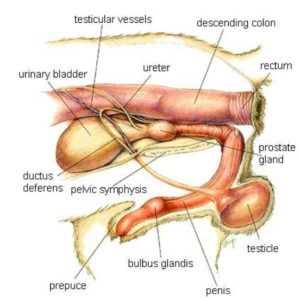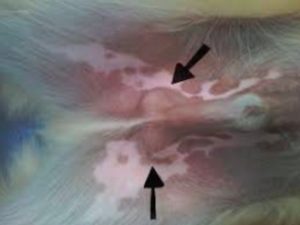Editor’s Note: Healthy Paws is a column sponsored and written by the owners of Clarendon Animal Care, a full-service, general practice veterinary clinic and winner of a 2017 Arlington Chamber of Commerce Best Business Award. The clinic is located 3000 10th Street N., Suite B. and can be reached at 703-997-9776.
Have ever experienced this scenario?
You have a wonderful new male puppy and one day he rolls over for a belly rub and you notice these two round swollen bumps at the base of his penis. Your puppy seems super happy and not at all bothered by the bumps, but you become really worried that something is wrong. Are those his testicles? Does he have an infection? Are they tumors?
 Your happy puppy — now bored and confused that you keep staring at his belly — bounds off and grabs one of his favorite chew toys, seemingly unfazed by this new problem.
Your happy puppy — now bored and confused that you keep staring at his belly — bounds off and grabs one of his favorite chew toys, seemingly unfazed by this new problem.
You then pick up the phone to call your vet and when they start asking you to describe these mysterious new bumps, you go back to look at your puppy and the bumps are completely gone. “I can’t find them anymore,” you say, “but I swear they were there by his penis and REALLY big.” Luckily, your vet tells you not to worry, because these bumps are a normal part of your boy dog’s anatomy — called the bulbus glandis.
 The bulbus glandis is generally not noticeable, but will often swell and become very apparent when male (neutered and intact) dogs become excited — like when they are happy to see you and roll over for a belly rub.
The bulbus glandis is generally not noticeable, but will often swell and become very apparent when male (neutered and intact) dogs become excited — like when they are happy to see you and roll over for a belly rub.
So why do dogs have a bulbus glandis? Contrary to the what the name implies, the bulbus glandis is not a gland at all, but actually functions during mating to complete the “coital tie,” which keeps the male and female dogs somewhat locked together until mating is complete.
Luckily, when the bulbus glandis swells it does not cause any discomfort to your pup and does not require any medical intervention. However, if you notice any unusual areas of swelling on your dog, it is never wrong to seek the advice of you veterinarian.


